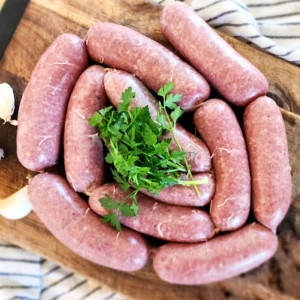
Nose-To-Tail Beef Sausages Recipe
Made with organ meats, collagen-rich scraps, and any beef cuts you like, these nose-to-tail homemade beef sausages are a true staple in my freezer. Nutritious, delicious, and incredibly affordable, they make a hearty meal and a wonderful ingredient for many recipes.
Equipment
- Cutting board and knife(s).
- Meat grinder
- Large mixing bowls.
- Sausage stuffer or stuffer meat grinder attachment (optional, if making links).
- Needle or sausage pricker (optional, if making links).
Ingredients
- 2 lbs (~1kg) beef muscle meat
- 10 oz (~300 g) beef heart
- 9 oz (~250 g) beef tongue
- 3 oz (~85 g) beef liver
- 3 oz (~85 g) beef kidney
- 1 to 1½ lbs (~450 to 680 g) beef fat and collagen scraps
- 4-5 tsp sea salt
- 2-3 tsp black pepper
- 2-3 cloves garlic
- 1-2 tsp dry parsley
- 1 tsp dry sage
- 1 tsp crushed mustard seeds
Instructions
Make the sausages
- Gather and prepare all your ingredients. Weigh the different types of meats and fat, then cut everything into roughly 1-inch cubes. If your meat isn’t already partially frozen, spread the cubes on a tray and place them in the freezer until firm but not completely solid (about 1 hour). Place all your clean bowls and grinder parts in the fridge or freezer to chill as well.
- While you wait, weigh and prepare your seasonings. If using fresh garlic, mince it finely.
- Assemble your meat grinder with the chilled parts, following the manufacturer’s instructions. Use a coarse or medium die for grinding.
- Remove the meat and fat from the freezer and combine them in a large, cold bowl. Mix with clean hands to evenly distribute fat and organ meats.
- Grind all the meat, collecting it in a large, cold bowl or tray.
- Add the seasonings and mix quickly with clean hands to distribute everything evenly. Return the mixture to the fridge or freezer while you wash and sanitize your equipment and surfaces. Place your sausage stuffer parts in the freezer to chill.
- Once everything is ready, mix the sausage mixture again until it becomes homogeneous and slightly sticky. You can mix by hand or use a stand mixer with a paddle or dough hook attachment.
- If you want to make stuffed sausages continue with the next section. If making patties, simply form the mixture into patties with clean, slightly damp hands and place them on a parchment-lined tray. Keep them refrigerated, cook immediately, or freeze (see notes).
Stuff into casings (optional)
- While the sausage mixture rests in the fridge or freezer, prepare your casings. For natural hog casings, rinse thoroughly and soak in warm water for about 15 minutes. Then run warm water through each casing to remove any salt and check for leaks. Follow the specific directions provided with your casings.
- Assemble your sausage stuffer, or use your grinder fitted with the stuffer attachment without the blade and die. Slip a casing all the way onto the stuffing tube, tie a knot at the end, and prick a small hole near the knot to let trapped air escape.
- Gently push the meat mixture through the stuffer, letting it fill the casing as it coils. Adjust the pressure or speed as needed: if air pockets form, decrease speed and/or push casing further in onto the stuffing tube; if it overfills, try increasing speed, and/or sliding the casing closer to the tube's end.
- Once you reach the end, leave enough casing to tie another knot. Form links at your desired length, alternating the direction of each twist to keep them secure.
- Prick any air bubbles with a sterilized needle or sausage pricker. Your sausages are now ready to cook, refrigerate, or freeze.
Notes
Scroll up on the ingredient notes for tips to choose and prepare your meats, as well as for alternative seasoning ideas, and all my tips to make the perfect sausages every time.
Uncooked sausages will keep in the fridge for up to 5 days.
To freeze, arrange patties or links in a single layer on a parchment-lined tray and freeze until solid. Then transfer them to a zip-top bag (you can cut links apart first) and store for up to 3 months.
To cook these sausages: pan-fry, bake, grill, or simmer in stews and soups. Cooking time will vary with size, and sausages are done when browned on the outside and cooked through inside.